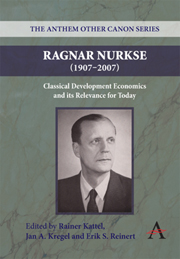Book contents
- Frontmatter
- Contents
- Preface
- Title in the series
- 1 The Relevance of Ragnar Nurkse and Classical Development Economics
- 2 Life and Time of Ragnar Nurkse
- 3 Nurkse and the Role of Finance in Development Economics
- 4 Early Development Theory from Sun Yat-sen to Ragnar Nurkse
- 5 The Roots of Unequal Exchange: Mihail Manoilescu and the Debate of the 1930s
- 6 Nurkse and the Early Latin American Structuralists: A Reflection on Development Theory, Industrialization and their Relevance Today
- 7 Lewis, the Long Wave and Industrialization in the Periphery
- 8 Ragnar Nurkse and the Law & Economics of Development
- 9 Ragnar Nurkse's Development Theory: Influences and Perceptions
- 10 Nurkse meets Schumpeter: Is Microfinance a ‘Silver Bullet’ to Economic Development?
- 11 Stockpiling of International Reserves and Development: a Misguided Link
- 12 International Currency Experience and the Bretton Woods System: Ragnar Nurkse as Architect
- 13 Some Reflections on Nurkse's Patterns of Trade and Development
- 14 India and Development Economics: External Influences and Internal Responses
- Notes
12 - International Currency Experience and the Bretton Woods System: Ragnar Nurkse as Architect
Published online by Cambridge University Press: 05 March 2012
- Frontmatter
- Contents
- Preface
- Title in the series
- 1 The Relevance of Ragnar Nurkse and Classical Development Economics
- 2 Life and Time of Ragnar Nurkse
- 3 Nurkse and the Role of Finance in Development Economics
- 4 Early Development Theory from Sun Yat-sen to Ragnar Nurkse
- 5 The Roots of Unequal Exchange: Mihail Manoilescu and the Debate of the 1930s
- 6 Nurkse and the Early Latin American Structuralists: A Reflection on Development Theory, Industrialization and their Relevance Today
- 7 Lewis, the Long Wave and Industrialization in the Periphery
- 8 Ragnar Nurkse and the Law & Economics of Development
- 9 Ragnar Nurkse's Development Theory: Influences and Perceptions
- 10 Nurkse meets Schumpeter: Is Microfinance a ‘Silver Bullet’ to Economic Development?
- 11 Stockpiling of International Reserves and Development: a Misguided Link
- 12 International Currency Experience and the Bretton Woods System: Ragnar Nurkse as Architect
- 13 Some Reflections on Nurkse's Patterns of Trade and Development
- 14 India and Development Economics: External Influences and Internal Responses
- Notes
Summary
Introduction
‘Bretton Woods’ is many things. Superficially, it is the New Hampshire resort where the globe's soon-to-be victorious nations agreed in principle to a new postwar order. It is also the ‘Bretton Woods institutions’, which gave rise to the World Bank, the International Monetary Fund and, with some delay, the World Trade Organization. And it is the most ambitious international monetary experiment in human history: the ‘Bretton Woods system.’ Governments of most of the world's main trading nations agreed to guarantee the price of dollars in their local currency. To appreciate this brio, imagine a government agreeing internationally to guarantee the price of any asset: a home, a share, a bond. As one of the foremost monetary law experts at the time commented, ‘The new plans are of a complication entirely unprecedented in the history of international law’ (Nussbaum 1944, 256).
How was this possible? One answer is Ragnar Nurkse. His International Currency Experience: Lessons of the Inter-war Period perfectly supported the case made by Keynes and White for an audacious codification of international finance. Nurkse's book sought to uncover the sources of interwar economic implosion; its villain is the international monetary system. The account is so thorough, so accessible and so compelling that its basic premises were considered axiomatic well into the second half of the twentieth century.
- Type
- Chapter
- Information
- Ragnar Nurkse (1907–2007)Classical Development Economics and its Relevance for Today, pp. 267 - 282Publisher: Anthem PressPrint publication year: 2009
- 1
- Cited by



